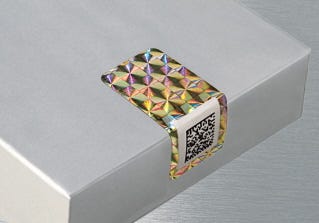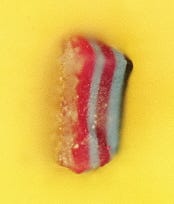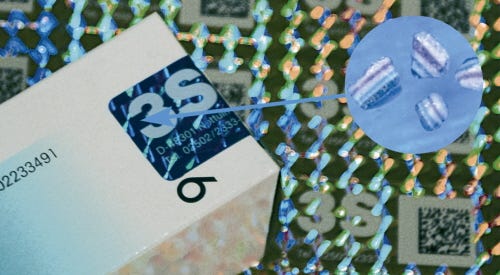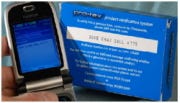A Genetic Fingerprint in Colour-Code
January 30, 2014
 Like a genetic fingerprint, SecuPack, developed by 3S Simons Security Systems GmbH, can be added to primary and secondary packaging as a legally binding counterfeit protection. Folded cardboard boxes, tubes and blister packaging of different materials secured with SecuPack enable on the spot authentication. Additionally, customary product security systems like seals, labels, holograms and closures can be optimised with the 3S technology.
Like a genetic fingerprint, SecuPack, developed by 3S Simons Security Systems GmbH, can be added to primary and secondary packaging as a legally binding counterfeit protection. Folded cardboard boxes, tubes and blister packaging of different materials secured with SecuPack enable on the spot authentication. Additionally, customary product security systems like seals, labels, holograms and closures can be optimised with the 3S technology.
The SecuPack 3S technology is based on the smallest micro colour-code particles, called SecuTag. SecuTags are made of melamine alkyd polymers, manufactured in different sizes ranging from 8 to 90 micrometers (μm). With the so-called sandwich method, the different colour components are layered on top of each other. The selection of the colours and their sequence make up over 4.35 billion individual company codes. If two or more colour-codes are combined, the number of possible codes is practically infinite. The layers are prepared with normal, ultraviolet or infrared colours and can optionally be provided with magnetic properties. The colour-codes are heat resistant up to 200ºC (392ºF) over a long period of time and up to 350ºC (662ºF) for a short time span. The particles also are resistant to organic solvents and chemicals, such as acids, bases and diluters.
 In its purest form SecuTag has the substance of a very fine powder. In this condition, the code is added to various transfer media, such as clear varnish, adhesives and resins before it is applied onto a packaging. The colour-codes can also be combined with pastes, polymers in solution, liquids, powders and granulates. The colour-codes can be applied to different materials by established printing processes, directly added to the products or applied by a dispenser. The dispenser offers the possibility of easy application during the packaging process as no major changes in the packaging line are required. The application is effortlessly accomplished in-line with the packaging of the product. As a result, application on almost every solid matter, such as metal, plastic, paper, glass, aluminium and textiles, is possible.
In its purest form SecuTag has the substance of a very fine powder. In this condition, the code is added to various transfer media, such as clear varnish, adhesives and resins before it is applied onto a packaging. The colour-codes can also be combined with pastes, polymers in solution, liquids, powders and granulates. The colour-codes can be applied to different materials by established printing processes, directly added to the products or applied by a dispenser. The dispenser offers the possibility of easy application during the packaging process as no major changes in the packaging line are required. The application is effortlessly accomplished in-line with the packaging of the product. As a result, application on almost every solid matter, such as metal, plastic, paper, glass, aluminium and textiles, is possible.

It is a nice system and without doubt forgery-proof, but it has one big, big, problem. Colour-code protection is invisible to the eye, which means that the consumer is not able to verify himself the authenticity of the product he wants to buy. The retailer can, as a standard pen microscope is sufficient for identification, but the retailer can be as tricky as counterfeiting is profitable. No counterfeiting technology, how ingenious it might be, is satisfactory as long as the consumer can’t check it himself. I wrote before, it is time for the industry to include the consumer in its efforts to fight counterfeiting.
* All hi-tech solutions, as inks, authentication, tracking and tracing are useless. You can only track and trace your own genuine products, not the counterfeited ones as they don’t have the codes. So, what happens: You discover a non-coded fake. What does it give you? In the meantime consumers have bought a fake and are disappointed by the quality, taste, fragrance and never buy your brand again. ….. read the full article: “Counterfeiting: The Industry is on the Wrong Track”
All hi-tech solutions, as inks, authentication, tracking and tracing are useless. You can only track and trace your own genuine products, not the counterfeited ones as they don’t have the codes. So, what happens: You discover a non-coded fake. What does it give you? In the meantime consumers have bought a fake and are disappointed by the quality, taste, fragrance and never buy your brand again. ….. read the full article: “Counterfeiting: The Industry is on the Wrong Track”
About the Author(s)
You May Also Like


